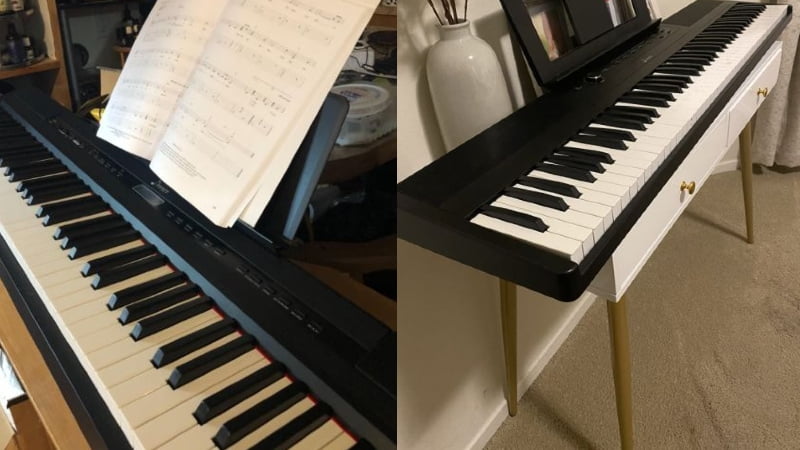Donner is known for their great beginner pianos at a competitive price. And because of this, I chose to compare two of their top beginner models in this Donner DEP-20 vs DEP-45 comparison. While they both came with a host of great features, in the end, the Donner DEP-20 was the winner.
But what makes the Donner DEP-20 better than the DEP-45?
At the end of the day, it all boiled down to the tones. Simply put, the Donner DEP-20 featured a better range of tones and higher quality voices than the DEP-45. On top of that, the DEP-20 features better hammer action and a wide range of piano features that make it one of the best beginner pianos out there.
With all that said, the Donner DEP-45 came with its own set of good features too, particularly a wide range of playing modes and a very affordable price, which makes it a great option for pianists on a tight budget.
Donner DEP-20 vs DEP-45: Comparison Chart




Last update on 2025-04-17 / Affiliate links / Images from Amazon Product Advertising API
Donner DEP-20 vs DEP-45: The Differences
To determine a definitive winner between these two pianos, I decided to compare all their features head to head. And when all was said and done, the final score was 3-1 in favor of the Donner DEP-20.
The progressive hammer action, superior tone, and a wide variety of different playing modes ultimately made the Donner DEP-20 the better option between the two.
Tone
The winner: Donner DEP-20
When I compared the tone of these two instruments, I didn’t have a hard time choosing the winner. The Donner DEP-20 features a more sophisticated tone generation system, sound library, and set of effects that overall gave it a better sound than the DEP-45. And since tone is one of the major factors to consider when buying a piano, this was a huge point in the DEP-20’s favor.
+ Tone Generation
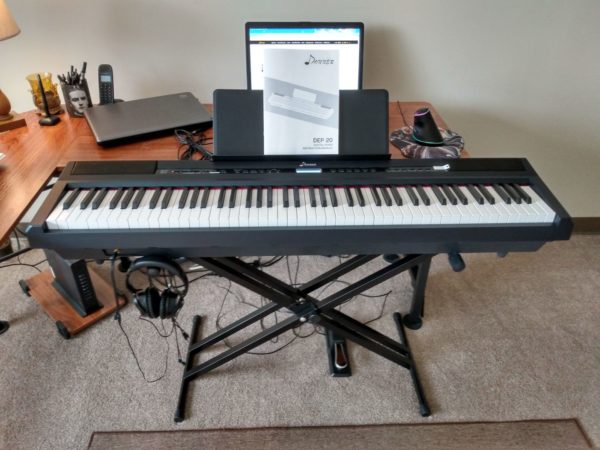
The Donner DEP-20 uses the AWM sampling method originally pioneered by Yamaha on their digital pianos. While it follows the same principles as traditional sampling techniques, AWM sampling uses higher-quality samples with natural decay.
Usually, digital pianos will use a digital decay on their samples to save on memory. While I couldn’t find any confirmation while doing my research, it definitely sounded like the Donner DEP-45 used the more traditional sampling approach.
The difference between the DEP-20’s AWM method and the traditional method on the DEP-45 is the sound quality. Even if you aren’t well versed in the world of pianos and music, it’s really easy to tell that the DEP-20 features more realistic, crisper, and brighter piano tones than the DEP-45.
+ Sound Library
When comparing this aspect of the two pianos, it was almost no contest. The Donner DEP-45 only features 15 voices. Now, for a beginner piano, this should be more than enough. You have a couple of choices in regards to acoustic pianos, electric pianos, synths, bass, and string sounds that give you a fair amount of versatility.
And while the 15 voices of the DEP-45 are great, they simply paled in comparison to the DEP-20. The Donner DEP-20 has a massive sound library with over 238 different voices that give you a whole lot of options. This beats out the DEP-45 by miles and is one of the main reasons I declared the DEP-20 the winner.
Granted, if you’re a beginner, some people might say that 238 voices is too much as it distracts you from the main piano sound. However, having too many sounds is usually better than not having enough, and the added versatility of the Donner DEP-20 is one of the main reasons it’s one of the top beginner pianos on the market today.
+ Effects
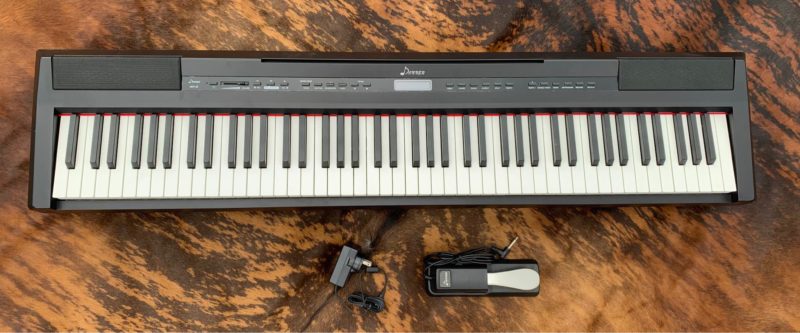
In terms of effects, the Donner DEP-45 was a slight let down. Since it’s a very affordable piano, I didn’t expect it to come with a wide range of effects, but the fact that this piano has no built-in effects is disappointing.
While effects aren’t necessary, especially for beginners, they do a great job of helping you customize your tone. The Donner DEP-20 comes with both reverb and chorus effects, which are the two major effects that every pianist needs. With these effects, you can add a lot of depth and texture to your tone and create unique sounds that will have everyone turning their heads.
Feel & Playability
The winner: Donner DEP-20
Comparing the feel and playability of the Donner DEP-20 wasn’t the fairest fight. Since the Donner DEP-20 has progressive hammer action compared to the semi-weighted action on the DEP-45, the DEP-20 was the winner by a long mile. On top of that, it also has adjustable touch response, which makes for a more pleasant experience.
+ Hammer Action
One of my favorite features on the Donner DEP-20 is the progressive hammer action. This is about par for the course for its price range, but it’s always nice to see a beginner’s piano with progressive hammer action. With progressive hammer action, the keys on the left side are significantly heavier than the higher keys, which replicates the feel of an actual piano. Different brands have different ways of accomplishing this, and I found that the DEP-20 replicates an acoustic piano very well, although the action is on the louder side.
In comparison, the Donner DEP-45 only has semi-weighted keys. There’s a large debate about the benefits of semi-weighted keys and whether they are better for children and beginners, but the majority of piano players do not enjoy playing on semi-weighted keys. While the keys are lighter and easier to press, they feel very different from the keys on an acoustic piano, which can get in the way of your playing.
So, while it might be harder to get used to the hammer action of the DEP-20 if you’re a beginner, it’s worth it in the long run as it trains your fingers and arms to get used to the weight of an acoustic piano.
+ Key Texture
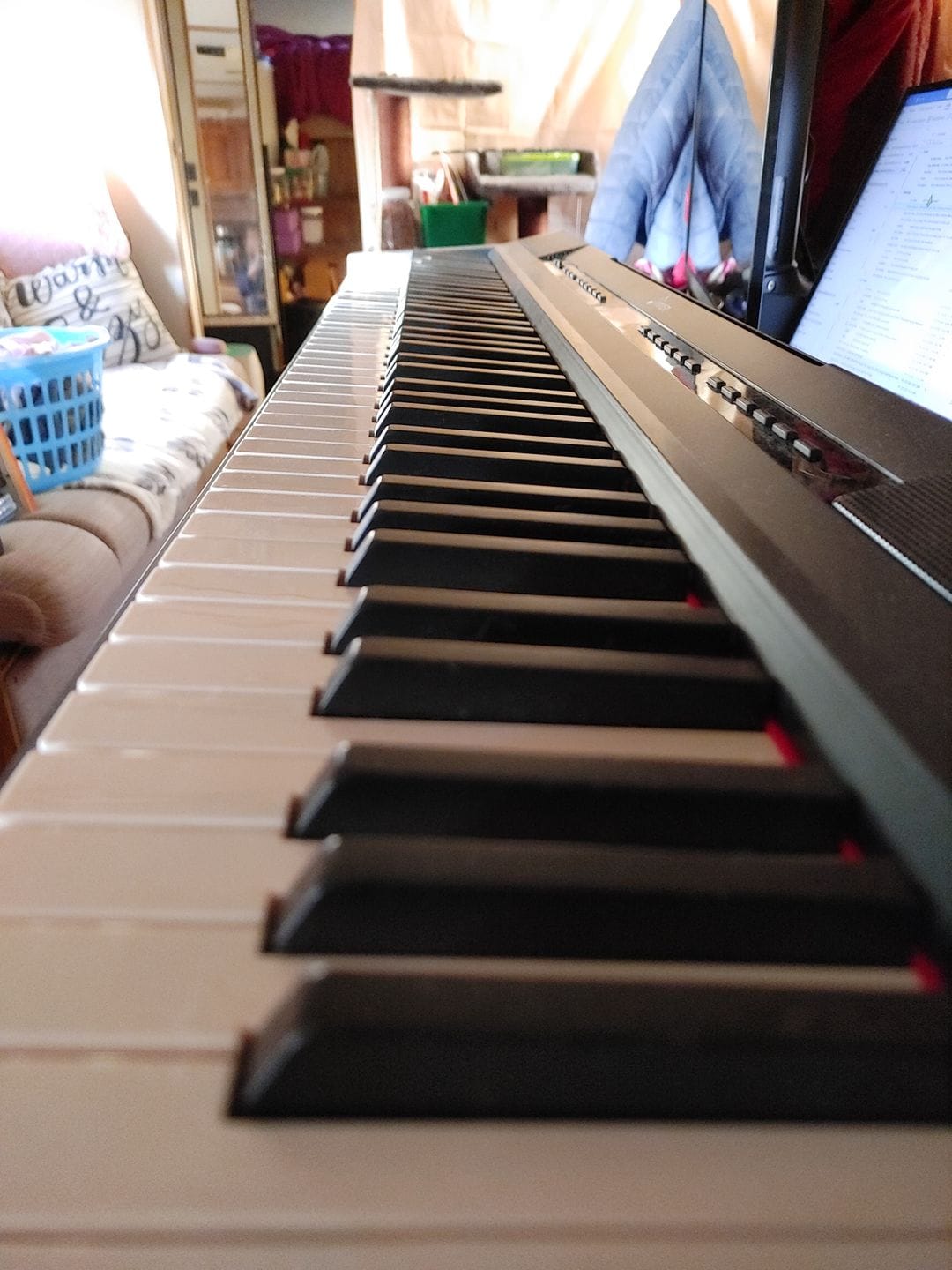
The key texture of both of these pianos is nothing special. They both feature plastic keys with a glossy finish, which isn’t something I’m a fan of. This is because glossy keys take away from the realism of the piano, and when you start playing faster and more intense pieces of music, the slippery texture is very evident.
Granted, these keys aren’t the most glossy or slippery on the market, but I would have liked to see some sort of coating to give it a matte or textured finish that’s easier for the fingers to grip.
+ Touch Response
Another reason I found the DEP-20 to be the clear winner is its touch response. The Donner DEP-20 has adjustable touch response, meaning you can tweak the sensitivity of the keys to your own tastes and preferences. If you have lighter hands, you can set the sensitivity to soft, and if you need a heavier feel, you can easily set the sensitivity to hard. This is a fairly advanced feature that many beginners won’t really notice, but once you do and set the piano to the right touch response, it will be much easier for you to nail those tricky techniques.
In contrast, there is no adjustable touch response on the Donner DEP-45. Since it’s a budget-friendly option, this isn’t exactly a knock on its quality. However, it’s a glaring flaw when you compare it to the DEP-20.
Piano Features
The winner: Tie
I was genuinely surprised when writing this comparison that the Donner DEP-45 comes with a bunch of different piano features. The DEP-20 also comes with a host of different features, and it seemed like whatever was missing on the DEP-45 was present on the DEP-20 and vice versa. For this reason, I decided to declare this aspect of the comparison a tie.
+ Playing Modes
The Donner DEP-20 comes with a very robust split mode that has a ton of functions when playing live music. With this setting, you can divide the piano into two separate keyboards with different voices. This gives off the illusion of playing two instruments at the same time and has a lot of applications in live performances and even jams with friends. For example, you can set a bass voice on the left side and a piano voice on the right side and play a running bass line while decorating it with piano chords on top.
There are also one finger chord settings on the DEP-20, which is a fun way to play songs and chords without that much effort. However, once you gain some experience and skill on the piano, you probably won’t find that many uses for this setting.
The DEP-45, on the other hand, comes with a different type of split mode. Instead of dividing the piano into two separate voices, it divides it into two mini-keyboards. So, you can play piano duets as if there are two separate pianos playing at the same time. This feature is also very useful in piano classes, as the student and teacher can play at the same time without crossing over at any point.
+ Polyphony
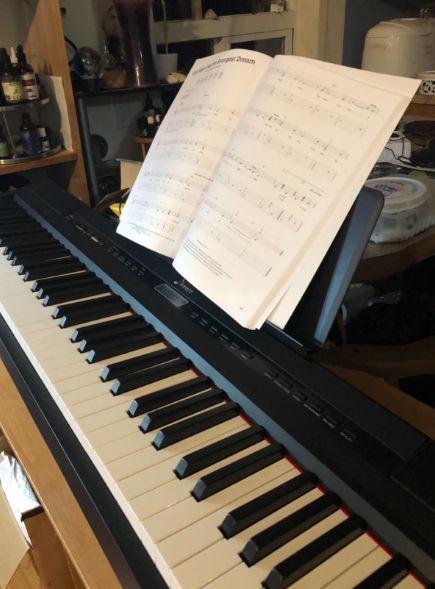
Both of these pianos have the same polyphony at 128. This is a great number for any digital piano, and even if you’re playing dense chords with the sustain pedal on, there’s little to no chance that you will hit the maximum. However, if you’re utilizing the split mode on the DEP-45, you may hit the limit if you play too many notes and sounds at the same time.
+ Connectivity
In terms of connectivity, both of these pianos do a great job. They both have inputs for pedals, headphones, and an external sound system, which are staple features of a good digital piano. However, the connectivity option that stood out for me is the MIDI connection. Both of these pianos support MIDI connectivity, which is more than you can say about a lot of options in this price range.
With MIDI connectivity, you can connect the piano to a computer to control virtual instruments or hook it up to piano learning apps. In fact, in this regard, the Donner DEP-45 even has a slight advantage as it supports BlueTooth connectivity on top of USB MIDI connectivity.
Donner DEP-20 vs DEP-45: The Similarities
These two pianos come from the same brand, so you should expect a couple of similarities. For starters, they are both full-key portable digital pianos. If you’re a piano student looking for an instrument for practicing and jamming, portable digital pianos are the way to go. Both of these pianos also feature 128-note maximum polyphony, which is a great feature for any digital piano.
Another similarity between these two pianos is the target market. Both of these pianos come with a wide set of features geared for beginner pianists, which is why they are great options for first-time players. The DEP-45 is less expensive, which is what makes it great for anyone shopping on a budget.
However, the Donner DEP-20 comes with more features, voices, and versatility, which is why I believe it’s well-worth the extra costs.
Quick Rundown of the Donner DEP-20
- 🎹 【Full-Weighted 88 key keyboard】The digital electric piano is constructed by 88 full-sized hammer action keys with adjustable touch response. This 88-key weighted keyboard allows to adjust your desired playing style.
- 🎹 【238 Tones & 128 Polyphony】 The 88-key weighted keyboard loaded with 238 types of tone like Ukulele, drum, bass, etc. vividly presenting voices of different instruments, arousing your keen to learn music. The digital electric piano with 128-note max polyphony, players could distinguish tone clearly in Chorus & Reverb under various occasions.
- 🎹【Double Keyboard & Control Panel】This 88 key weighted keyboard provides dual-tone mode for combining two voices together, like piano and drum, inspiring to make a new creation. Panel includes sustain pedal, triangle pedal and audio inputs & outputs, perfectly used for music arrangement and an ensemble.
- 🎹 【Multi-Media Settings】This digital piano features with a backlit LCD screen for clearly showing chords names and notation and adjusting wanted tones, recording mode-MIDI, MP3 Player and two 25W amplifiers, bringing you richer and better experience of practice and performance.
- 🎹【Multi-Purpose 88 key keyboard】This streamlined 88-key piano is designed for rehearsing, learning and creating, practice or performance.
Last update on 2025-04-17 / Affiliate links / Images from Amazon Product Advertising API
Quick Rundown of the Donner DEP-45
- 【Thin & Portable】Portable digital piano. The thickness of the dimensions is less than 4 inches. 88-key half weight keyboard. Equipped with the same 1:1 ratio keyboard design as the acoustic piano and with adjustable touch response functions to suit your preferred playing style, helps beginners to develop finger strength. Provide you a good feeling and playing experience.
- 【Amazing sound experience】Portable electric piano samples timbre from the acoustic piano. Equipped with 10W speaker * 1 and 10W tweeter * 1. Bright treble and rich bass make the sound more delicate. Also equipped with the latest 128 multi-tone digital chip, to avoid the loss of sound when playing. Insuring that you will get a better experience.
- 【Bluetooth&Excellent teaching piano】DEP-45 digital piano keyboard is powerful and especially suitable for teaching. Dual keyboard partition function. DEP-45 can be divided into two keyboard areas of the same pitch, convenient for one-to-one teaching. By the Bluetooth MIDI function, you can connect this piano to external devices/apps for more mainstream gameplay.
- 【Support multiple devices】DEP-45 electric keyboard comes with a complete hardware interface for external expansion, so you can plug in headphones without disturbing others. It also has a USB MIDI interface and can be connected to a computer or other external device for music editing or recording (via the music software in the device). Single/multi - pitch pedal interface. If you need more, you can also use another port to connect other pedals.
- 【Easy to carry】Measuring just 50.4 "x 12" x 3.7 "(16 pounds), the digital keyboard is easy to take it out. It will be a good companion for you to travel and join in impromptu live music any time
Last update on 2025-04-17 / Affiliate links / Images from Amazon Product Advertising API
Product Video
Related Articles to Donner Dep 20
- Donner DEP-20 vs DDP-90: Which Donner Piano Wins Out?
- Yamaha P45 vs Donner DEP 20: Which Model Is the Better Option for Beginners?
- Donner DDP-100 vs DEP-20 Comparison: Can the DEP-20 Beat Out the Donner Console Piano?
- Donner DEP-20 vs Alesis Recital Pro Comparison: Two Great Pianos Designed for Beginners
- Donner DEP-10 vs DEP-20: Which Is the Best Beginner Keyboard Under $500?
- Yamaha P71 vs Donner DEP-20: Which Is the Best Beginner Piano?
References:
- Donner DEP-20 Fully Weighted 88 Key Portable Digital Piano with Sustain Pedal: https://www.donnerdeal.com/products/donner-dep-20-beginner-digital-piano-88-key-full-size-weighted-keyboard-portable-electric-piano-with-sustain-pedal-power-supply
Lulacruza is an electronic folk duo operating at the junction of the hypermodern and the ancient. Our music weaves together hypnotic female singing, South American folk instruments and electronic processing, while channeling pulsating waves from the source of creation.
Lalucruza is also a community where you can connect with other music lovers to collaborate, exchange ideas and share knowledge. A platform for who wants to learns the basics of playing piano, guitar, drum masters’ technique, etc.. is the premise of our website.
